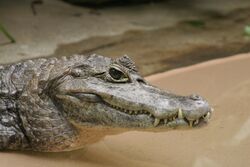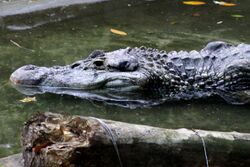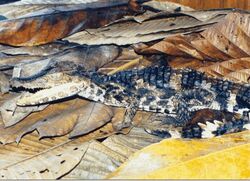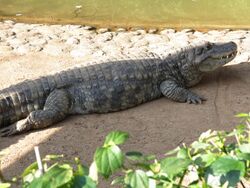Caiman
Topic: Biology
 From HandWiki - Reading time: 5 min
From HandWiki - Reading time: 5 min
| Caimans | |
|---|---|
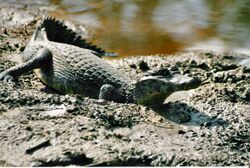
| |
| Yacare caiman, Caiman yacare | |
| Scientific classification | |
| Domain: | Eukaryota |
| Kingdom: | Animalia |
| Phylum: | Chordata |
| Class: | Reptilia |
| Clade: | Archosauromorpha |
| Clade: | Archosauriformes |
| Order: | Crocodilia |
| Family: | Alligatoridae |
| Subfamily: | Caimaninae Brochu, 1999 |
| Type genus | |
| Caiman Spix, 1825
| |
| Genera and species | |
|
See below | |
A caiman (/ˈkeɪmən/; also cayman as a variant spelling[1] from Taíno kaiman[2] ) is an alligatorid belonging to the subfamily Caimaninae, one of two primary lineages within the Alligatoridae family, the other being alligators. Caimans inhabit Mexico and Central and South America from marshes and swamps to mangrove rivers and lakes. They have scaly skin and live a fairly nocturnal existence. They are relatively small-sized crocodilians with an average maximum weight of 6 to 40 kg (13 to 88 lb) depending on species, with the exception of the black caiman (Melanosuchus niger), which can grow more than 4 m (13 ft) in length and weigh in excess of 1,000 kg (2,200 Ib). The black caiman is the largest caiman species in the world and is found in the slow-moving rivers and lakes that surround the Amazon basin. The smallest species is the Cuvier's dwarf caiman (Paleosuchus palpebrosus), which grows to 1.2 to 1.5 m (3.9 to 4.9 ft) long. There are six different species of caiman found throughout the watery jungle habitats of Central and Southern America. The average length for most of the other caiman species is about 2 to 2.5 m (6.6 to 8.2 ft) long.
Caimans are distinguished from alligators, their closest relatives, by a few defining features: a lack of a bony septum between the nostrils, ventral armor composed of overlapping bony scutes formed from two parts united by a suture, and longer and sharper teeth than alligators, plus caimans tend to be more agile and crocodile-like in their movements.[3] The calcium rivets on caiman scales make their hides stiffer.
Several extinct forms are known, including Purussaurus, a giant Miocene genus that grew to 12 m (39 ft) and the equally large Mourasuchus, which had a wide duck-like snout.[4]
Behavior
Caimans are predators and, like alligators and crocodiles, their diet largely consists of fish. Caimans also hunt insects, birds, small mammals and reptiles.
Due to their large size and ferocious nature, caimans have few natural predators within their environments. Humans are their main predators, because the animals have been hunted for their meat and skin. Jaguars, anacondas and crocodiles are the only other predators of caimans, although they usually prey on the smaller specimens. During summer or droughts, caimans may dig a burrow and go into a form of summer hibernation called aestivation.
Female caimans build a large nest in which to lay their eggs. The nests can be more than 1.5 m (4.9 ft) wide. Female caimans lay between 10 and 50 eggs, which hatch within about six weeks. Once they have hatched, the mother caiman takes her young to a shallow pool of water, where they can learn how to hunt and swim.
Phylogeny
Caimaninae is cladistically defined as Caiman crocodylus (the spectacled caiman) and all species closer to it than to Alligator mississippiensis (the American alligator).[5][6] This is a stem-based definition for caimaninae, and means that it includes more basal extinct caimanine ancestors that are more closely related to living caimans than to alligators.
Below is a cladogram showing the phylogeny of Caimaninae, modified from Hastings et al. (2013).[7]
| |||||||||||||||||||||||||||||||||||||||||||||||||||||||||||||||||||||||||||||||||||||||||||||||||||||||
Taxonomy
- Subfamily Caimaninae
- Genus †Acresuchus
- Genus †Brachychampsa[8]
- Genus †Bottosaurus[9]
- Genus †Centenariosuchus
- Genus †Chinatichampsus
- Genus †Protocaiman
- Genus †Kuttanacaiman
- Genus †Gnatusuchus
- Genus †Culebrasuchus
- Genus †Eocaiman
- Genus †Globidentosuchus
- Genus Paleosuchus
- P. palpebrosus, Cuvier's dwarf caiman
- P. trigonatus, smooth-fronted caiman
- Genus †Purussaurus
- Genus †Mourasuchus
- Genus †Necrosuchus
- Genus †Orthogenysuchus
- Genus †Tsoabichi
- Genus Caiman
- C. yacare, yacare caiman
- C. crocodilus, spectacled caiman
- C. c. crocodilus, spectacled caiman
- C. c. apaporiensis, Rio Apaporis caiman
- C. c. fuscus, Brown caiman
- †C. lutescens
- †C. venezuelensis
- †C. wannlangstoni
- †C. brevirostris
- C. latirostris, broad-snouted caiman
- Genus Melanosuchus
- †M. fisheri
- M. niger, black caiman
References
- ↑ Dictionary.com, retrieved February 16, 2021
- ↑ Patte, Marie-France (2010). "Arawak vs. Lokono. What's in a name?". in Faraclas, Nicholas. In a Sea of Heteroglossia: Pluri-Lingualism, Pluri-Culturalism, and Pluri-Identification in the Caribbean. Curaçao: Fundashon pa Planifikashon di Idioma & Universiteit van de Nederlandse Antillen. p. 80. ISBN 978-99904-2-300-6.
- ↑ Guggisberg, C.A.W. (1972). Crocodiles: Their Natural History, Folklore, and Conservation. David & Charles. p. 195. ISBN 978-0-7153-5272-4.
- ↑ Brochu, C. A. (1999). "Phylogenetics, Taxonomy, and Historical Biogeography of Alligatoroidea". Society of Vertebrate Paleontology Memoir 6: 9–100. doi:10.2307/3889340.
- ↑ Brochu, C. A. (2003). "Phylogenetic approaches toward crocodylian history". Annual Review of Earth and Planetary Sciences 31 (31): 357–97. doi:10.1146/annurev.earth.31.100901.141308. Bibcode: 2003AREPS..31..357B. http://www.naherpetology.org/pdf_files/970.pdf. Retrieved 2021-07-26.
- ↑ Brochu, C. A. (2011). "Phylogenetic relationships of Necrosuchus ionensis Simpson, 1937 and the early history of caimanines". Zoological Journal of the Linnean Society 163: S228–S256. doi:10.1111/j.1096-3642.2011.00716.x.
- ↑ Hastings, A. K.; Bloch, J. I.; Jaramillo, C. A.; Rincon, A. F.; MacFadden, B. J. (2013). "Systematics and biogeography of crocodylians from the Miocene of Panama". Journal of Vertebrate Paleontology 33 (2): 239. doi:10.1080/02724634.2012.713814. Bibcode: 2013JVPal..33..239H.
- ↑ Rio, Jonathan P.; Mannion, Philip D. (2021-09-06). "Phylogenetic analysis of a new morphological dataset elucidates the evolutionary history of Crocodylia and resolves the long-standing gharial problem". PeerJ 9: e12094. doi:10.7717/peerj.12094. ISSN 2167-8359. PMID 34567843.
- ↑ Adam P. Cossette (2020). "A new species of Bottosaurus (Alligatoroidea: Caimaninae) from the Black Peaks Formation (Palaeocene) of Texas indicates an early radiation of North American caimanines". Zoological Journal of the Linnean Society 191: 276–301. doi:10.1093/zoolinnean/zlz178.
Wikidata ☰ Q478759 entry
mk:Кајмани
 |
 KSF
KSF